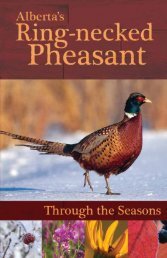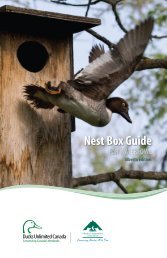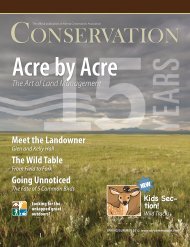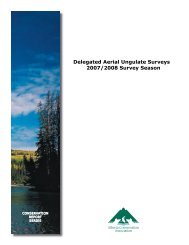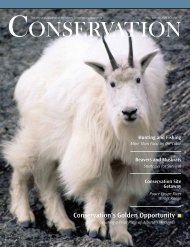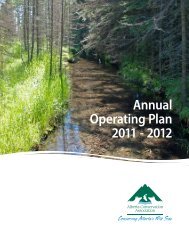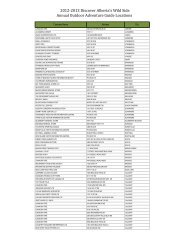2012-2013 - Alberta Conservation Association
2012-2013 - Alberta Conservation Association
2012-2013 - Alberta Conservation Association
You also want an ePaper? Increase the reach of your titles
YUMPU automatically turns print PDFs into web optimized ePapers that Google loves.
Abundance and Population<br />
Structure of Walleye in Milk<br />
River Ridge and Forty Mile<br />
Coulee Reservoirs<br />
Regular assessment of the<br />
abundance and structure of walleye<br />
populations in <strong>Alberta</strong> is necessary<br />
to evaluate the effectiveness of<br />
current management strategies.<br />
We conducted Fall Walleye Index<br />
Netting surveys on Milk River Ridge<br />
and Forty Mile Coulee reservoirs to<br />
determine the current status of these<br />
walleye populations. We captured<br />
232 walleye at Milk River Ridge<br />
Reservoir, with an estimated catchper-unit-effort<br />
of 19.8 fish/100 m 2<br />
of net/24 h. Walleye ranged in size<br />
from 105 to 690 mm fork length and<br />
in age from young-of-the-year to 14<br />
years. Males reached maturity by age<br />
three and females by age seven. We<br />
captured 193 walleye at Forty Mile<br />
Coulee Reservoir, with an estimated<br />
catch-per-unit-effort of 18.7 fish/100<br />
m 2 of net/24 h. Walleye ranged in<br />
size from 203 to 686 mm fork length<br />
and in age from one to 15 years.<br />
Males reached maturity by age three<br />
and females by age five.<br />
Partnerships<br />
<strong>Alberta</strong> Environment and<br />
Sustainable Resource Development<br />
Beaverlodge Riparian<br />
<strong>Conservation</strong><br />
Bank-side livestock feeding and<br />
watering, vehicle fording, and instream<br />
alterations have degraded<br />
the riparian areas within the<br />
Beaverlodge River drainage.<br />
Since 2004, we have partnered<br />
with landowners, provincial and<br />
municipal governments, and other<br />
conservation organizations to<br />
deliver riparian restoration and<br />
conservation projects within the<br />
Beaverlodge watershed. These<br />
projects have included streambank<br />
fencing, alternative livestock<br />
watering systems and tree planting.<br />
We identify potential project<br />
sites and approach the associated<br />
landowners to collaboratively plan<br />
riparian enhancement projects. As<br />
projects are delivered, we arrange for<br />
the collection of baseline vegetation<br />
and water quality information,<br />
which allows us to monitor the<br />
impact of riparian restoration<br />
activities. In <strong>2012</strong>/13, we and our<br />
partners co-ordinated the planting<br />
of 6,149 trees at three sites, including<br />
one new project site and two ongoing<br />
project sites. We signed three habitat<br />
enhancement agreements with<br />
landowners who received trees. In<br />
total, these agreements enhanced<br />
13.7 ha (33.9 ac) of riparian habitat<br />
along approximately 1.4 km of<br />
stream length.<br />
Partnerships<br />
<strong>Alberta</strong> Agriculture and Rural<br />
Development, ConocoPhillips,<br />
County of Grande Prairie, Penn<br />
West Energy, Royal Bank of Canada,<br />
West County Watershed Society<br />
Clearwater River Core Area<br />
Bull Trout Status<br />
The majority of <strong>Alberta</strong>’s bull trout<br />
populations are classified as being At<br />
Risk or at High Risk of extirpation<br />
according to <strong>Alberta</strong> Environment<br />
and Sustainable Resource<br />
Development’s ranking system. The<br />
Clearwater River core area bull trout<br />
population is classified as being<br />
at High Risk of extirpation. The<br />
objective of our study is to determine<br />
the distribution and abundance<br />
of bull trout in the Clearwater<br />
River core area. We used a patchbased<br />
approach for monitoring<br />
bull trout distribution modified to<br />
enable occupancy estimation and<br />
modelling. We delineated patches<br />
using stream order, elevation and<br />
watershed area resulting in 23<br />
patches in the Clearwater River core<br />
area. We determined five sample<br />
reaches per patch are necessary<br />
to achieve a false absence rate of<br />
0.2 given an estimated bull trout<br />
detection probability of 0.3. We<br />
considered patches to be occupied<br />
when we captured at least one<br />
juvenile bull trout (≤150 mm fork<br />
length). We used angling and<br />
electrofishing gear to estimate adult<br />
bull trout (≥250 mm fork length)<br />
abundance at four reaches on the<br />
Clearwater River. In <strong>2012</strong>/13, we<br />
captured 62 bull trout ranging in<br />
size from 74 to 402 mm fork length<br />
at 35 sample reaches. We detected<br />
juvenile bull trout in three of eight<br />
patches sampled this year for a total<br />
of nine detections in the 22 patches<br />
(41%) sampled in 2011 and <strong>2012</strong>.<br />
Bull trout catch at the river reaches<br />
ranged from 0 to 1.2 fish/km. Our<br />
catch was insufficient for a valid<br />
abundance estimate at any of the<br />
reaches. We will attempt to estimate<br />
abundance again in spring <strong>2013</strong>.<br />
Partnerships<br />
<strong>Alberta</strong> Environment and<br />
Sustainable Resource Development,<br />
<strong>Alberta</strong> Stream Watch <strong>Conservation</strong><br />
Coalition<br />
Distribution and Abundance<br />
of the Migratory Bull Trout<br />
Population in the Castle River<br />
Drainage<br />
<strong>Alberta</strong>’s bull trout populations<br />
have declined over the last century<br />
due to anthropogenic disturbances<br />
including habitat fragmentation<br />
and degradation, migration<br />
barriers, introduction of nonnative<br />
fish species, and overharvest.<br />
In southwestern <strong>Alberta</strong>, the<br />
distribution of bull trout has been<br />
reduced to approximately 31%<br />
of its historical range. Current<br />
populations, all of which are at<br />
risk of extirpation, exist only in<br />
headwater streams. The status of<br />
these remnant bull trout populations<br />
is unclear due to limited data. We are<br />
conducting multi-year population<br />
and spawning habitat assessments<br />
throughout the Castle River<br />
drainage to update the status of<br />
these remnant populations. During<br />
the fall of <strong>2012</strong>, we installed fish<br />
traps in the South Castle River, West<br />
Castle River, Carbondale River and<br />
Mill Creek to capture post-spawn<br />
migratory bull trout. We marked<br />
all adult bull trout (>300 mm fork<br />
length) with an internal transponder<br />
tag to track individuals during<br />
recapture events. We captured a total<br />
of 150 adult migratory bull trout<br />
in four major spawning streams:<br />
35 in South Castle River, 4 in West<br />
<strong>Alberta</strong> <strong>Conservation</strong> <strong>Association</strong> – Annual Report <strong>2012</strong>/<strong>2013</strong><br />
25





